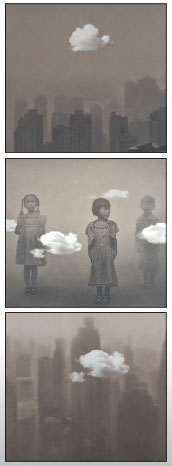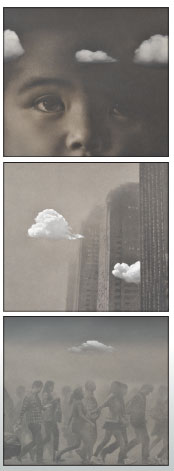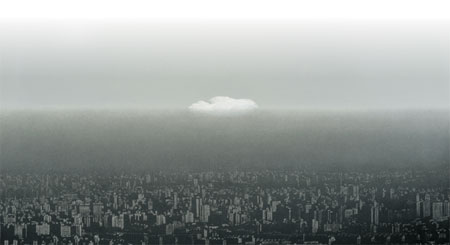Urban blight transformed as art
Updated: 2014-10-17 07:03
By Timothy Chui(HK Edition)
|
|||||||||
|
The Realm of the Heart: a series of oil paintings by artist Zhu Yiyong exploring the effects of pollution on China's modern urban landscapes. Provided to China Daily |
Zhu Yiyong responds to the pollution intensifying over Chinese skies by painting panoramic vistas blurred by a film of soot and grime. The artist spoke to Timothy Chui about his artistic concerns
The latest series of paintings by Chinese contemporary artist Zhu Yiyong presents unshakable proof that the ravages of urban waste are best appreciated vicariously. Zhu brushes back at the epidemic of pollution plaguing the nation in his new series, which will tour Hong Kong, Taiwan and London from this month through May 2015.
The acclaimed Chinese painter calls the smoggy skies above China's cities the single greatest social problem today. Zhu's personal crusade was spurred forward a decade ago, when he was confronted with mountains of garbage during a sojourn to the outskirts of Chongqing.
"It was shocking, this rubbish station. It was massive and completely over-proportioned to the setting," he said, recalling how the alkaline stench crept over hundreds of square kilometers.
Zhu and a companion followed the stink to its source, an ominous looking mound rising over the horizon. The toxic vapors overwhelmed the artist. He said he still suffers from migraines brought on by sinus infections to this day.
The genesis of Zhu's newest landscape series The Realm of the Heart was borne out from that memory and contrasts the drab and smoggy scenes Zhu sees in nearly every major Chinese city with childhood memories, lying in meadows, tracking lone clouds drifting across an eternally blue sky.
The 20 pieces on display in Hong Kong until mid-November are a departure from Zhu's most highly acclaimed works, such as his Cat's Cradle portraits featuring red stars, spun by people indulging in the popular childhood pastime.
The dialogue between viewer and portraits which characterizes Zhu's earlier work is missing from the current series. The few Chinese depicted in the smog-shrouded vistas seem passively resigned to perpetual malaise. The people have become secondary to the polluted environment.
Zhu's detailing is characteristically exquisite, managing to stand out through the textured layers he paints over his finished works, as he recreates the soot and grime that disfigure urban views.
Zhu believes there is a certain Zen to his grey scale panoramas. Another common thread among most of the pieces is a single, cumulus cloud. The visible mass of water is the only purely white figure in the scenes, a pure yet alien presence floating above cities and among street scenes suffocating under a grainy sky.
Zhu may have grown weary of pollution, but he has no plans for relocating to Hainan Island, one of the few pristine places that remain in China, he said. He prefers to stay close to his hometown and muse, Chongqing, which served, alongside Beijing, to provide the smoggy urban settings depicted in the paintings. Hong Kong has not been spared in the Chinese mainland's growing pollution problem either, Zhu said, noting that the local air quality seems to have deteriorated steadily since his first visit in 1995, although it's not nearly as bad as the air on the mainland.
"It will take a very long time before we will see an improvement in the environment. It won't be the government alone who can fix this problem, it will require each and every person in China to make changes," he said.
Contact the writer at tim@chinadailyhk.com


(HK Edition 10/17/2014 page7)
